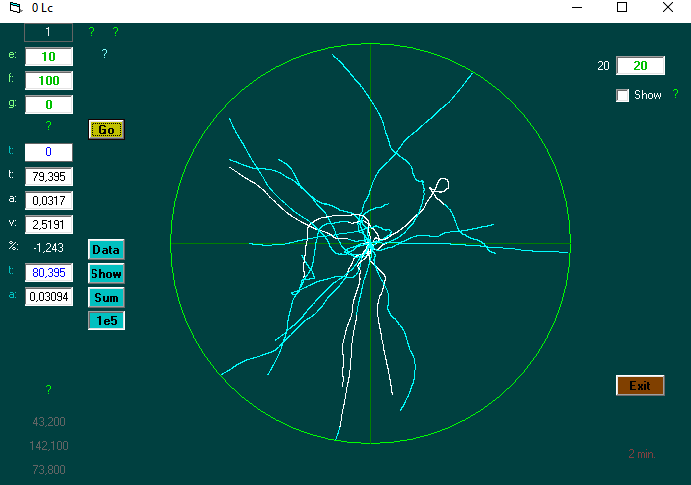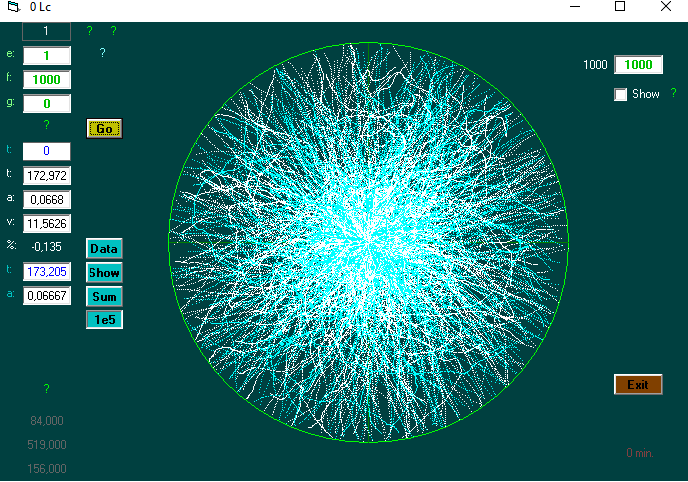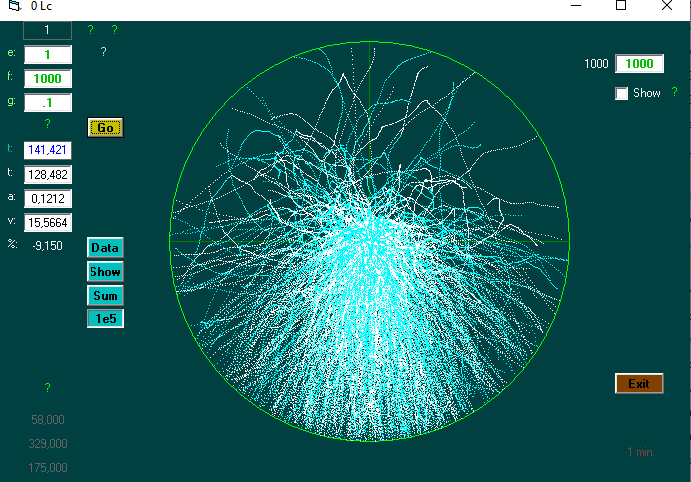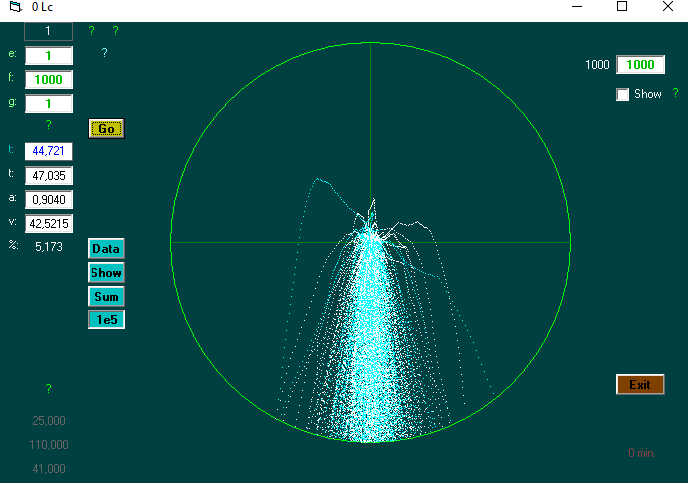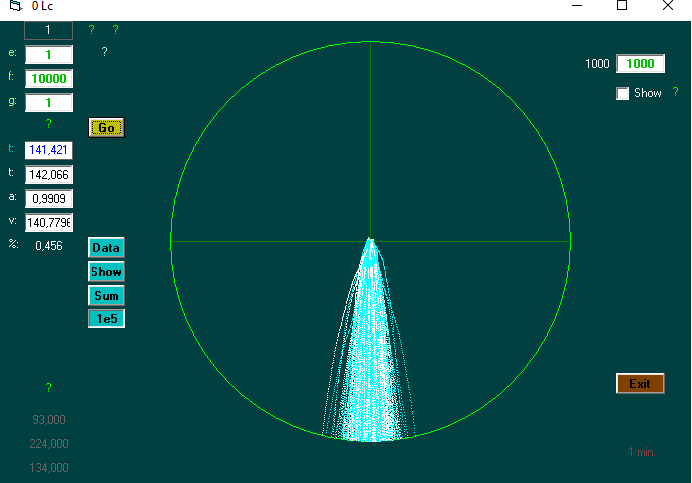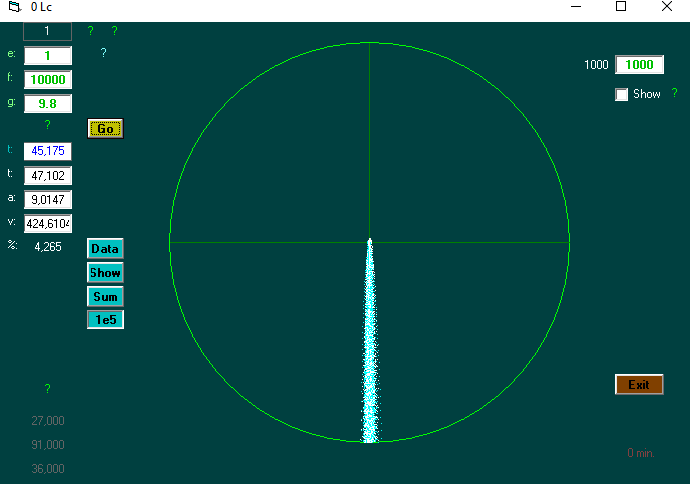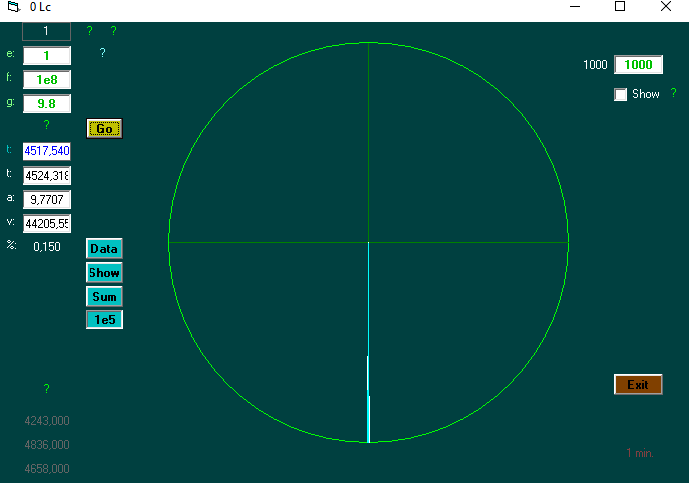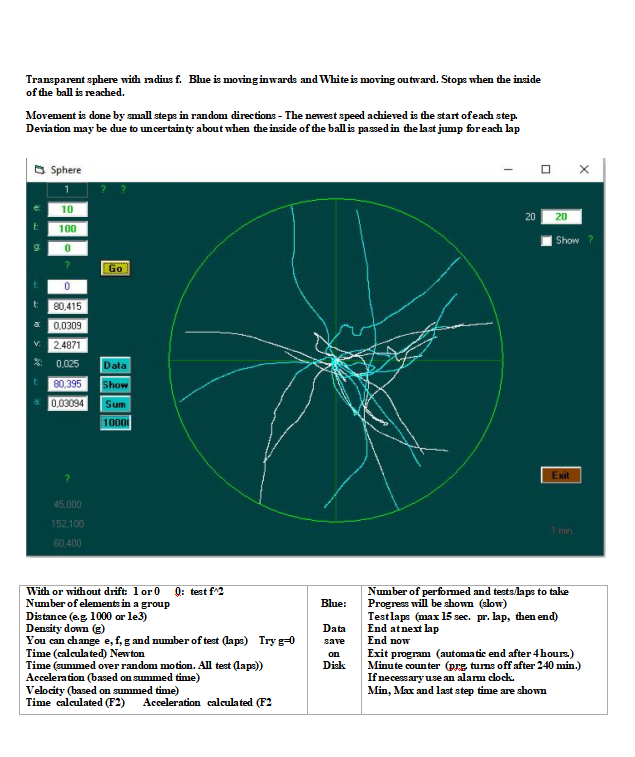Overall overview of the content of the random walk challenge
At the bottom there are simulation graphics
The nature of gravity
What is indigestible substance for some may be delicious candy for others ..
Georg's postulates:
The Space consists of quantum fluctuations.
The 3 dimensions of space must be added a density factor.
Motion of mass objects occurs by displacement.
Time is a concept.
Gravity, “g” occurs by random motion.
Everything physical, consists of quantum fluctuations.
There is a correlation between gravity and the expansion of space.
----
Here, vacuum, space and ether is the same thing.
Our space is perceived by us in 3 dimensions. The real space has an extra density dimension indication on each of the 3 dimensions.
If space is not a physical and distancing medium, everything will be completely close to each other. (the ancient greek had a similar perception)
There are two ways in which objects can move - either self-propagating without max. speed. (This is how speed was previously perceived) -
- Or self-propagating in a medium at a maximum speed depending on the nature of the medium. In the physical universe, the latter will always apply.
We are not able to observe events happening on quantum level – we can (almost) only guess.
These events happens at inconceivable speeds and with almost incredible small fluctuations..
The frequency of the quantum fluctuations specifies the speed of light C.
(how? )
The smallest things we are able to measure is in the order of 10-12 m.
The diameter of an atom is estimated to 10-10 m.
The diameter of a nucleus is estimated to 10-14 m and the electrons (and quarks) <10-18 m.
Planck time (5,39 × 10-44 s) is defined as the time required for light (300.000 km/s) to travel a distance of 1 Planck length in space (1,6 × 10-35 meters).
https://en.m.wikipedia.org/wiki/Quantum_fluctuation
The cosmological principle: that the universe is homogeneous and isotropic is not consistent with today's facts. (However convenient for mathematicians)The universe is not homogeneous; it only appears so.
https://en.m.wikipedia.org/wiki/Gravitational_lens
The universe consists of quantum fluctuations.So do mass objects.
We are only able to see mass objects.
Hereafter I will refer to quantum fluctuations as flips (flip-flops)
Everything consists of flips.
The vacuum does not move, but the flips of mass objects fluctuate so that they can "shift in space" by random processes through the vacuum.
The vacuum does not move, but is constantly distributed in the surroundings.
It renews itself through fluctuations. (and conditions are transferred - (cause and effect)).
It is constantly a new edition.
Thus, the historical speculations on Earths motion in the ether is not relevant.
Distance consists of a number of flips. There are x flips in a meter (how many ?).
If you were able to see it - there would be most space where the density of the flips was greatest.
And one could state that a certain mass object would take up space for x number of flips.
When a mass object is “unleashed in space”, the random and ultra-swift pushes of the flips defines the speed and direction of the motion. And the direction with the most space (flips) is the most probable.
When light passes through a "tight" vacuum, the passage takes longer / is slowed down. (when viewed from the outside!).
Again, the light is able to pass (around) a black hole, and we will observe that the passage happens faster than if it travels through the black hole (ok, which it cannot).
To describe a black hole as a singularity is absurd.
And there is no such thing as a pointlike mass object.
Space is like a solid, friction-less, non-visible gel, in which the transversal electromagnetic waves of light advances.
(Lorenz et al around 1900).
In which the light (photons) displaces itself in.. (today's description)
https://en.m.wikipedia.org/wiki/Luminiferous_aether
https://people.compute.dtu.dk/jerf/papers/on_LL.pdf
The vacuum is not frictionless in the normal sense, but due to the ultra-short life of the flips. And "friction" first occurs at enormous speeds. Of course, the "speed" / frequency of the fluctuation cannot be exceeded.Motion of mass objects occurs by displacement.
From a starting point, there are always 360 degrees to choose from. If one degree actually has more space than others, it will mean that a random choice of this direction will increase in probability.
The displacement of a mass object only stops upon contact with another mass object. ?
Why is the more dense vacuum surrounding our planet stable? (“the gravitational-field”)
Increasing quantum fluctuations.
Expanding space / universe.
The increase in quantum fluctuations occurs especially with mass objects (- which contain relatively more flips).
Occasionally 2 quantum fluctuations become 3. Therefore, fluctuations can create an extra - how often and under what circumstances?
https://en.m.wikipedia.org/wiki/Hubble%27s_law
The Hubble constant which is about 70 (km/s)/Mpc (3.09E+22 m),shows that we are not able to measure the deviation of space in the solar system
The Gravitation constant G is 6.674×10-11 m3 ·kg-1 ·s-2
Hence a very small gravitational force per kg.
This suggests that new flips are present around the mass on 1 kg. Which means that the density of the flips is a bit bigger.
- (all the time) How many? Are they advancing into the vacuum?
The advancement of the new flips can not happen any faster than the speed C (which is defined by the fluctuations “frequency” – mean frequency?)
If the distances (flips) are great (dense) enough, then a local collapse are bound to happen due to C.
The large creation of atomic nuclei. (via plasma..) (the Big Bang)
In this collapse, new mass objects consisting of quantum fluctuations (flips) are created via a plasma period..
Mass objects are moved by displacement in the vacuum. At quantum level.
Here, completely different and almost incomprehensible scenarios are at play.
Electric: Vacuum permittivity e0 = 8,854·10-12 F/m.
Magnetic: Vacuum permeability µ0 = 10-07 H/m.
The vacuum values of permittivity e0, permeability µ0 og and speed of light C are interconnected, as e0µ0 = 1/c2 .)
..and at almost incomprehensible speeds.
Try to imagine the number of quantum events happening in a second.
Then try to imagine the number of seconds that have passed since the Big Bang more than 13 billion years ago. (4,3+17sec.)
If each quantum event should have a duration of 1 second, then many more seconds will be needed ..
Inertia
When all the “dipoles” of the mass objects are to be changed and set in a new position/direction/speed, it requires energy – and it is inertia.
(Changing the position of a gyroscope, it requires energy.)
Time
Time is a concept which can only be utilized by beings with consciousness and memory. Nature have neither.
Images / impressions that we perceive will always be stored in a sequential way in our memory. Evolution has arranged it this way. “The arrow of time” points in one direction only.
We can never observe the present. What we observe is always the past.
We are not able to influence the present - only the near future.
Time is not physical. Of course, it can be used to show a course of events or predictions.
==
Simultaneity ..
Let's say it takes the light 1 sec. to reach the moon ..
2 clocks are synchronized: UrA and UrB.
PersonA keeps UrA on the earth.
PersonB travels with UrB to the moon.
If personA observes UrB on the journey, personA will see that UrB loses more and more ..
When PersonA sees urB on the moon, it is seen that urB goes 1 sec. too slow. (due to the distance)
When PersonB sees urA on the ground, it is seen that urA goes 1 sec. too slow. (due to the distance)
PersonB travels with UrB back to earth.
If personA observes UrB on the journey, personA will see that UrB loses less and less ..
When PersonB is back on Earth, it is seen that UrB shows the same as UrA.
- Of course, simultaneity is relative when light has a speed.
It has nothing to do with the physical clock.
==
The present..
- But first there is probably agreement that only the present exists and the past and future do not.
And that the present is a timeslice in a very small milimy_time ..
How on earth can it be possible that both we and very distant galaxies physically appear in the same time slice. - At the same time !?
Is that weird?
....
Real universal simultaneity must be a physical truth, even though Einstein "proved that universal synchronization is not possible".
Newton said: "absolute time flows smoothly .."
Time flows nowhere. - Only in our consciousness.
By recalculating and comparing the present of places, simultaneity can be quite easily (simply) proven when you know the distance.
Wherever you can go, there is simultaneity! (otherwise you would not be able to be seen elsewhere)
Watching from a distance shows different "times / clock times" and says nothing about physical simultaneity.
-
How on earth can it be possible that both we and very distant galaxies physically appear in the same time slice. - At the same time !?
The question is wrong ..
It should instead be: Why is there a dynamic universe made up of a collection of quantum fluctuations? And which represents both our 3 dim. space and our present ..
Maybe it's of necessity "nothing can not always exist"?
==
Something completely different..
RT: "The speed of light is the same in all initial systems".
That statement holds only in an empty universe.
The problem is that a philosophical construct, empty universe does not exist physically!
Try once to look at a starry sky on a dark night. There is not a chaos of celestial bodies moving away at all possible speeds.
If you hang a swinging pendulum up in a frictionless position, it will eventually stop the movement.
Likewise with a moving body in the empty space.
One day you will find what you can call a universal mean time, with which you will then be able to calibrate time meters.
==
Gravity time distillation ..
When there is a gravitational field around the earth, it corresponds to the space being a little denser. Contains longer distances ..
If you look at a meter stick on the ground from a distance and flash with a light source from one end to the other, it will (seen from the outside) look like the light is delayed when it hits the other end of the fixed stick.
==
At first?
More and more space was created (vacuum).
When the speed of expansion (creation of new flips) came close to C, a collapse happened in which mass objects were created. As micro “black holes” (mass objects consisting of flips and with more dimensions).
When the density of the flips surrounding the black holes is the same as on the inside, the black holes will dissolve.
Only part of space became mass objects.
If we wish to test various events in vacuum, Georg's random function (3d. with drif) can be used to determine the probable time for a given distance: (e ^ (1 / 3)) * (f ^ (2 / 3)) * (3 ^ (0.5)), where e is elements in a group; f is the distance and here g is “0”.
(in the real space there are no places where g is exactly = 0.)
(Found in countless simulations. Is a mathematical model possible ?? See f85challche.php)
As it turns out, acceleration is also present at “0” g. (Due to drifting. Away from the starting point.. )
The random-software/program shows us how g arises by itself by random fluctuations in vacuum. (with different flip concentrations)
In the beginning of the gravitational movement, it is "extremely small"; it is a very small "attraction" that is accelerated. And only based on the random small pushes of the fluctuations in a slightly heterogeneous space.
The “0” g acceleration could contribute to the speed of the cosmic particles.
https://da.m.wikipedia.org/wiki/Kosmisk_str%C3%A5ling
The Planck constant h = 6.626176 x 10-34 joule-seconds. The Planck equation to describe the energy of a photon is E = hv, where v is the frequency.
Here we are dealing with extremely small energy levels and extremely great speeds.
(The red light from a standard diode peaks at a wave length of 660 nanometer in air. This is equivalent to a frequency of 454 terahertz (THz, tera = 10+12 ) or 454.000 billion oscillations per second)
The photons(bosons) move with the speed of the fluctuation frequency. (by displacement)
Mass objects need to be started with applied energy in order to align all the dipoles (and their flips). In principle, they would then continue with same speed and direction until they have contact with other mass objects.?
As more fluctuations are created, more space becomes available and it looks like space is expanding.
However, there are no independent motion of mass objects (galaxies). (A redshift can also be caused by the space being less dense at the time of the emission)
Quantum fluctuations, flips…
Constitutes space.
The more flips, the more space..
Flips interacts to create more..
There a many more flips in the mass objects than in the adjacent space.
In terms of speed, Flips will advance with less than C and will equal out the differences in concentration. (how?)
Mass objects will constantly form new flips, so there is a constant increase in flips around them. This increase decreases by 1/the distance to the mass object. (1 / r?). (but the mutual distance 1/r2?)
This will result in a greater probability for the mass objects to displace themselves by random movements towards the more space - “the more dense space”.
Gravity
And then we have g.
..
Can we figure out what space is?
Space density; the length contents of the distances; the longitudinal content of the spacers; the length of a length; curvature of the space; - it sounds like nonsense ...
Let's try to assume that space consists of quantum fluctuations. And that these fluctuate more than 10+50 times per second.
This also means that there are an incredible number of interactions per sec. - which we really can't grasp at all - that is probably the biggest challenge. It's not just thousands of billions or trillions of events per second, it's many more.
Can we figure out what space is?
It's where a mass object can be placed.
When all movement can only be done by displacement (like a ball moving on a digital screen), then there must be something to shift into, in advance.
Now a quantum fluctuation does not have a fixed quantity.? So seen from the outside (if one can) there may be more or fewer on an externally defined area. And it is a bit like a curvature in space which also corresponds to a curvature (tray) on a spherical surface. Seen from above, the speed (across the hill) is reduced.
So space consists of quantum fluctuations - without them: no room for anything.
So space is a physical media, of course.
--
A completely different matter is - Are physical laws present in advance?
Probably only the laws describing random quantum fluctuations ..
None .. but pure coincidences can still accomplish many things ..
A fluctuation is first in one state and then in another state - not necessarily in two equal parts.
It probably depends on the surrounding fluctuations close ..
It is not an particle / antiparticle event - the particles themselves are made of fluctuations..
If a mass object is to move (displace), all the parts (the fluctuations they consist of) must move in one direction and in most cases it will be in the same direction and at the same speed as the last displacement. (and remember .. there is plenty of time)
The future?
As more and more space (flips) is created, the density of the universe will increase (and thus also increase in distances ;-)) - until a new collapse occurs due to C and a new higher level of the universe will emerge, with its associated new physical laws.
Double-slit experiment..
Concerning the discussed double-slit experiment, it is hardly a surprise that only a very small proportion of the emitted electrons/photons hits the recipient screen and produces a point image after the interference. The remainder is converted to heat.
It is not possible to only emit one single electron/photon at a time!
To mix classical physics with more realistic physics would be blurred.
..
Mathematics can show/prove many “realities”.
Perhaps this can be used as inspiration..
Kind regards
Georg
If you should be interested in downloading the simulation-application with random walk 3d for
calculation of time over distances and with variable g –
please refer to:
Here you can find pictures of the various functionalities. The program also describes how it works.
If your supplier /Tech Giants/browser/security does not allow for you to download from the site: Please drop me an email and we will sort it out.
..
Evolution so far has not really shaped humans into being able to resolve the mysteries of existence - merely to cope with day to day hardships.
And, what happens at our level is almost eerily slower than where “existence” arises/happens.
Move your arm back and forth, and about 3 x 10+26 atoms with their subatomar part (you can feel it) will be aligned again and again.
The duration of the fluctuation is less than the Planck time at 5,39 × 10-44 second.
"Planck's units are completely unrelated to everyday physics. His length unit is e.g. 1.61 x 10-33 centimeter. This is 21 orders of magnitude of 10 less than one the diameter of the nuclei. It has about the same relative to atomic quantities, as the size of a human has for our galaxies!
Planck unit of time is even more amazing: 5.36 x 10-44 seconds. "
Physical conditions hard or impossible to proof are not necessarily untrue.
(It is time for a paradigm shift?)
...
